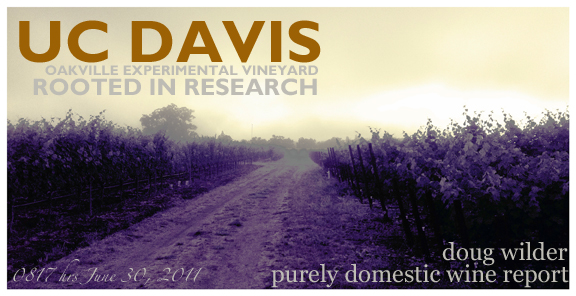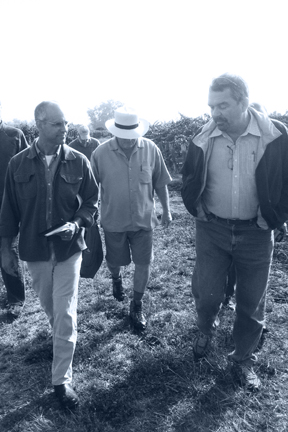Visiting the UC Davis Oakville Experimental Vineyard
 Saturday, July 2, 2011 at 14:35
Saturday, July 2, 2011 at 14:35 
One of the advantages of being a wine critic living in Napa Valley is I am seldom far from the action that essentially defines what I do. Meeting with producers I know and tasting their wines or finding out about new producers and chasing down their wines, then writing about them, is literally right under my nose. That has always been an important differentiator of what you read from me.
Beyond that ‘bread and butter’, too seldom are the opportunities to not only experience, but also appreciate some of the aspects of what goes into winemaking that most wine drinkers, or for that matter, wine writers never think about. About the only thing most of us notice besides what is in the bottle is the scenic beauty of the region. Those who have travelled to Napa Valley know what it looks like this time of year, a shimmering sea of undulating green canopy everywhere you look around the villages north of Napa. Come to think about it, the rest of the year isn’t so bad either.
Beneath this seemingly serene surface appeal, nature almost always presents a different reality to the grower and winemaker whose livelihood and success depend on dealing with what few of us see, much less understand. Countless factors need to be intelligently planned, correctly identified, effectively managed or eliminated long before grapes ever get picked. Pests, viruses, rootstock and clonal selection, canopy management, cover crops, vine density, soil science, vine direction, irrigation are just a few. Many of these factors such as rootstock selection, vineyard direction and density need to be planned for years before wine makes its way to the market.
Luckily, there is an extensive world-class resource for winegrowers and winemakers in the valley. It is the UC Davis Oakville Experimental Vineyard that occupies an anonymous forty-acre property on Oakville Grade Road. It is here that hundreds of different experiments have taken place on rootstock, clones, pruning, trellis, irrigation, cover crops and pests. Originally purchased by USDA in 1913, it languished post-prohibition and was deeded to the University of California in 1954 where formative research into viticulture and enology continues. Very few universities in the world own vineyards and those of this size and location are even rarer.
 David De Sante, (l), Jim Wolpert Ph. D (r)I have known about the existence of the station for many years but it wasn’t until I received an invitation from winemaker, David De Sante, to join him and a group of other winemakers for a crack of dawn visit to the site last week for a walk and discussion with Jim Wolpert, Ph.D, Viticultural Extension Specialist and Mike Anderson, Staff Research Associate that I actually had a reason to want to go. David mentioned that I would be the only writer on site. Since the science of viticulture is something I don’t understand well, I promised not to ask more than one stupid question. Usually I expect to have a wineglass and a note pad in my hand when I’m around winemakers. This was an opportunity to just relax, listen and be in the presence of some of the best minds in the business. The proverbial ‘fly on the wall’ maybe with a coffee cup instead?
David De Sante, (l), Jim Wolpert Ph. D (r)I have known about the existence of the station for many years but it wasn’t until I received an invitation from winemaker, David De Sante, to join him and a group of other winemakers for a crack of dawn visit to the site last week for a walk and discussion with Jim Wolpert, Ph.D, Viticultural Extension Specialist and Mike Anderson, Staff Research Associate that I actually had a reason to want to go. David mentioned that I would be the only writer on site. Since the science of viticulture is something I don’t understand well, I promised not to ask more than one stupid question. Usually I expect to have a wineglass and a note pad in my hand when I’m around winemakers. This was an opportunity to just relax, listen and be in the presence of some of the best minds in the business. The proverbial ‘fly on the wall’ maybe with a coffee cup instead?
In essence the facility reminds me of an artist’s studio with dozens of different canvas’ arranged in seemingly un-related patterns at different stages of completion. Only from the guidance offered by Jim and Mike was I able to get a sense of what the experiment was. It was a fascinating glimpse at an aspect of the wine industry that I think most of us take for granted -
Here is an example: I recall being told by winemakers that the reason yields may be down is because of a poor set after bloom. Intuitively, I have no problem understanding why that would affect yield but not until today did I have it explained to me in situ by a Ph.D and one of the brightest winemakers I know. Effectively, after bloom, the flower needs several consecutive days of temperatures over 74 degrees, fahrenheit to pollinate; chilly weather depresses that activity, so what you are left with is ‘bunches’ containing only a handful of widely-placed grapes. David pointed this out on a Sauvignon Blanc vine that required looking underneath the canopy to see any remnants of fruit. It wasn’t pretty…
What is up next? Jim Wolpert talked for a bit about the new winery at Davis where they produce micro batches of research wine in what apparently (as described by De Sante) looks like a biotech lab in its use of state-of-the-art technology. Separately, winemaker, Dawnine Dyer, has suggested I make the trip to the campus to see what is going on. Beyond that, Jim mentioned the first of the experimental wine produced from the site will be ready for a tasting next spring.
I look forward to be the fly on the wall again… without the coffee cup.
Select this link for more information on the UC Davis Oakville Experimental Vineyard



Reader Comments